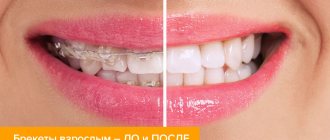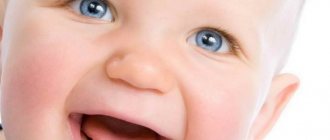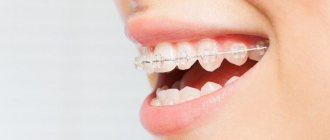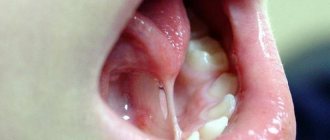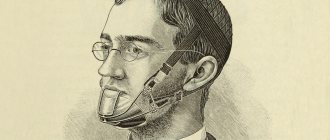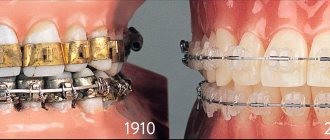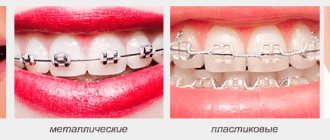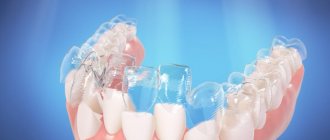Why do you need to get braces?
Uneven teeth complicate the processes of communication and socialization, as they look unsightly. They form many complexes. Bite defects and uneven dentition cause poor dental health (caries, periodontitis, wedge-shaped defects), problems with the gastrointestinal tract due to disruption of the process of chewing food. Bite pathology is associated with the appearance of health problems that have nothing to do with the digestive process.
It can be:
- pathology of the temporomandibular joint;
- the appearance of severe headaches;
- diseases of the ENT organs;
- poor posture.
Deformation of the facial skeleton and respiratory diseases are detected.
Suitable age for the child
Children are allowed to have orthodontic appliances installed from the age of 8-9, when baby teeth begin to be replaced by permanent ones. However, at this age there is no point in using braces; treatment with special aligners or a plate will suffice. The peculiarity of this treatment is that the aligners and plates can be changed as the child and his jaw grow, and expensive braces would have to be reinstalled.
Orthodontic treatment at an early age can be prescribed only in the most extreme cases, in the presence of very serious pathologies or the risk of their development in the future. As you know, at an older age, it is much more difficult to correct malocclusions and it takes longer.
Braces themselves are allowed to be installed from 11-12 years old. The main indications for installation: severe asymmetry of the jaw and disturbance in appearance, serious bite pathologies and, as a result, regular injury to the inner surface of the cheeks and tongue. The child may also have problems with diction and breathing, impaired swallowing function, and much more.
What types of structures are there?
There are different types of bracket systems according to their design features and method of attachment to surfaces.
Systems come in the following types:
- Vestibular – orthodontic structures attached to the front surface of the teeth. This is a more affordable option in terms of cost.
- Lingual – systems for correcting malocclusions that are glued to the inner surface of the tooth.
Orthodontic structures are made from various materials. For these products the following are used: metal with shape memory, plastics, ceramics, artificial sapphires, gold. Based on design features, they are divided into: self-regulating systems and ligature ones.
Timing of correction
For teenagers and young people under 25 years of age, correction will take a year and a half. While an adult will have to wear braces to correct his bite and teeth twice as long, sometimes up to 5 years.
The duration of wearing products after 30 is longer for the following reasons:
- Slow metabolism.
- Stopping the growth of the dental-jaw system.
- Tissue regeneration is slow.
Because of this, adults have to change their dentition (sometimes with removal), and shift incorrectly positioned teeth using an orthodontic device.
A wide selection of braces designs allows each patient to choose the optimal solution for treating disorders.
At any age, the application of correction will be successful and highly effective, the only difference being how long it will take.
From the video you will learn about braces for adults.
Mechanism of action
Correction by this method is based on the ability of teeth to shift under mechanical influence from the outside. They are fixed in the jaw in a movable manner. Systems allow units to be corrected to be offset. This happens by pulling them out of the alveolar process, or vice versa, by deep immersion into the socket. It allows you to rotate them around their axis or tilt them in the required direction. With prolonged exposure, the bone of the alveolar process is resorbed, freeing up space for displacement. On the opposite side, where the dental ligament is stretched, bone tissue grows and the tooth is fixed in the required position.
What is the installation
Installing braces is a difficult and lengthy process. A thorough examination is carried out before it.
The installation includes the following stages:
- The oral cavity is thoroughly prepared (treatment of all inflammatory processes in the oral cavity, carious teeth, professional cleaning);
- taking impressions of the jaws, making all the necessary calculations;
- manufacturing, individual adjustment of the system to the jaw, teeth;
- installation of an orthodontic system;
- patient adaptation to braces.
On average, any malocclusion pathology can be resolved with fixed orthodontic structures in up to two years.
Cost of treatment with braces in Moscow dentistry
The dentist can install high-quality braces. Price in Moscow for a teenager
determined depending on the type of design chosen.
On the website in the “Prices” - “Orthodontics” section you can see how much braces cost for a teenager
different types with installation. There is a discount program and installment plans for orthodontic treatment and other dental services.
All patients who leave reviews on the Aesthetics website are given a 3% discount on all dental services of the center (in addition to other discounts available to the patient).
Indications
When it is possible to put braces on a child, how can parents understand that he needs to correct the pathology of occlusion. Incorrect development of teeth and jaws becomes noticeable even in primary occlusion.
Signs to suspect that correction may be required:
- one or both parents have malocclusions;
- long-term disruption of nasal breathing;
- there are habits that can deform the dentition (finger sucking, foreign objects, prolonged pacifier sucking);
- visible dentition disorders;
- disproportionate development of the jaws;
- the child has diabetes and diseases of the nervous system.
In these cases, parents should take the student to an orthodontist for an examination. This is necessary to resolve questions about the advisability of correcting dental anomalies, installing braces for their children, and determining at what age it is best to start treatment.
Malocclusion in children and ways to correct it
The bite is the position of the upper and lower jaws when they are closed. The physiological (or correct) option is when the upper front teeth overlap the lower teeth by no more than a third, or touch the cutting edges. A different position of the jaws, as well as incorrect positioning of the teeth (displacement relative to the dentition, rotation around its own axis) is a reason to contact an orthodontist.
Causes of malocclusion in children
Parents can identify malocclusions on their own at the initial stage of changing baby teeth to molars. Warning signs include incorrect positioning of the jaws or incisors, difficulties with diction, and chewing food. To confirm the presence of a problem, determine its extent and ways to eliminate it, you should contact a dental clinic.
There are several causes of malocclusion in children:
- pathologies of intrauterine development, birth injuries leading to neurological disorders and, consequently, improper formation of the dental system;
- breastfeeding errors - during this period, nipple latching should be monitored during feeding, and only orthodontic pacifiers and pacifiers should be used;
- absence of teeth - premature removal, loss of one or more of them can lead to deformation of the entire row;
- problems with nasal breathing due to frequent ARVI, when a child, due to a stuffy nose, is forced to breathe through his mouth, constantly keeping it slightly open;
- lack of essential minerals and vitamins in the children's diet;
- poor posture - they lead not only to curvature of the spinal column, but also to incorrect position of the lower jaw.
Problems with nasal breathing are a common cause of malocclusion
To correct a malocclusion in childhood or adolescence, an orthodontist can offer different methods, focusing on the degree and nature of the disorder. For minor defects, it is recommended to use removable systems - double-jaw trainers, elastopositioners, orthodontic plates, mouth guards. However, in case of serious deformations, as well as to achieve a lasting positive result, the child should be given braces.
At what age is it established
There are different opinions among orthodontists about the age at which children can wear braces. Some believe that they can be installed from the age of seven. You just need to use special systems. Others believe that it is advisable to install them only in adolescence (over twelve years).
Before installation before adolescence, the following must be considered:
- It is advisable to install correction systems only after the eruption of the second molars, since there is a risk of teeth erupting in the wrong place;
- Mandatory examinations must be carried out to exclude severe defects in the development of the jaws, imbalances in the development of the facial skeleton and muscles;
- the length of the teeth must be sufficient to install locking fasteners;
- the enamel layer must be well developed, capable of withstanding the fastening of the system;
- It is necessary to find out how the load on the teeth occurs so that it does not become excessive when installing the system.
In a child of primary school age, structures are installed only according to strict indications. When delay leads to the development of defects that cannot be corrected if the structures are installed later. His general physical condition must be taken into account. Until the age of twelve, it is better to correct the bite using removable plates.
Brief summary
How long you wear braces on your teeth depends on many factors. The summary table will help you navigate the average time frame, depending on the existing defect that requires correction:
| Deadlines | Defect requiring correction |
| 1-1.5 years | Correction of minor anomalies:
|
| From 2 years | For severe pathologies:
|
| Up to 3 years or more | Correction of the most serious and even rare defects, some of which require preliminary surgical intervention. |
Do not forget that after removing the braces, the treatment does not end, since from this moment the retention stage begins. Its duration can vary from 3-6 years, and in particularly difficult cases - throughout life.
What problems may arise
Children are not able to maintain oral hygiene to the required extent. They do not take care of them, the structures may not last long, they break and the locks come unglued.
Other possible problems:
- Until the age of thirteen, children have soft and thin enamel. It is easily damaged when installing and wearing braces.
- The roots of the teeth are not yet strong. If the orthodontic structure is placed early, the roots may be destroyed and they will fall out.
- If correction systems are installed early, the teeth will become straight, but after they are removed as the jaw grows, curvature and discrepancy may occur again.
The question of at what age children get braces should be considered individually. Only an orthodontist can determine the age at which it is optimal for a child to have fixed structures installed based on individual indications and contraindications.
Installing braces for children
Installation of braces takes place in several stages:
- During the initial consultation, the orthodontist assesses the condition of the patient’s teeth, agrees on the type of system to be installed, and gives directions for diagnostic tests.
- An orthopantomogram and a teleradiogram (x-ray) are performed.
- Sanitation of the oral cavity and professional hygienic cleaning are carried out.
- Impressions are made, using which (together with x-rays), the doctor draws up a treatment plan.
- Immediately before installing the locks, the surface of the tooth enamel is polished and dried.
- Using special glue, the clasps are fixed to the teeth, and the arch is attached to them.
- The following technique is prescribed to activate (tighten) the system.
During the entire period of wearing braces, the child must regularly visit the orthodontist. The frequency of visits is determined by the type of system and the recommendations of the specialist.
During the installation process, discomfort and pain usually occur, but they pass within a few days. The procedure itself lasts on average 1 hour, in the case of ceramic systems – longer (from 2 hours).
Possible difficulties during the correction period
Wearing may be accompanied by discomfort and pain at first. Adaptation usually takes several days, after which the child gets used to the structure and ceases to feel it. Injuries to the oral mucosa are also possible, especially if a vestibular ligature brace system is installed. If the pain does not go away for a long time, the mucous membrane is constantly injured - you need to consult your doctor (perhaps errors were made during installation).
Another possible problem is poor diction. Most often it is observed in children who have been given a lingual system. Normally, a child should adapt within 2-3 weeks; longer problems with pronunciation are a reason to consult an orthodontist.
It is impossible to completely eliminate short-term discomfort after installing braces for children, however, the professionalism and experience of the specialists at the YuliSTOM clinic guarantee the absence of serious complications.

